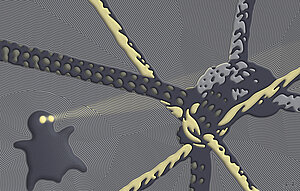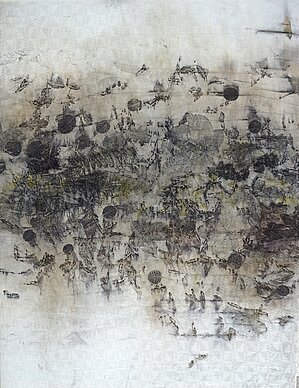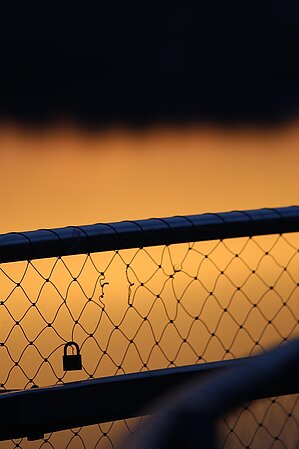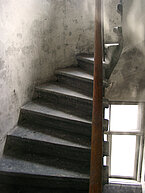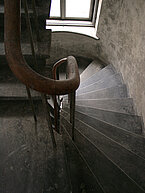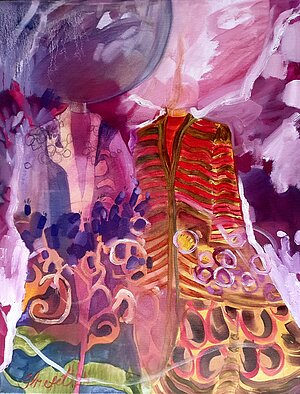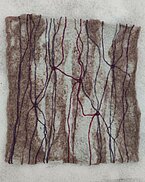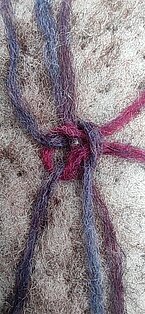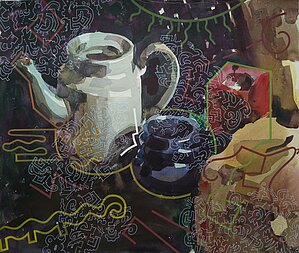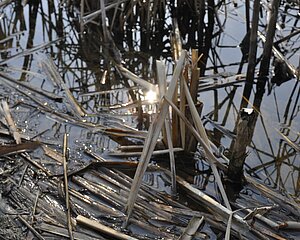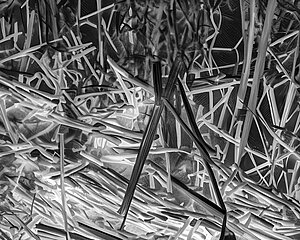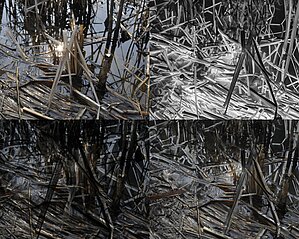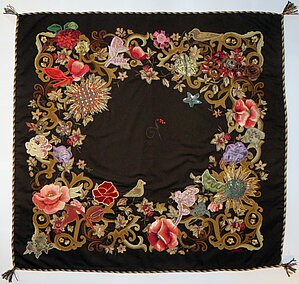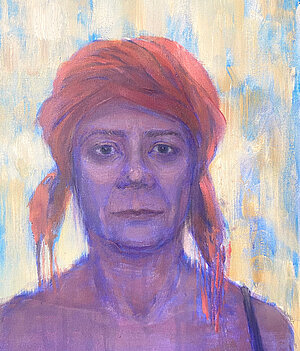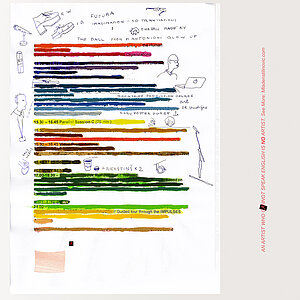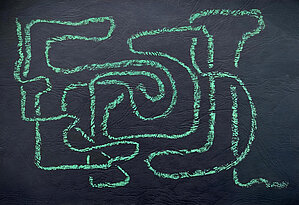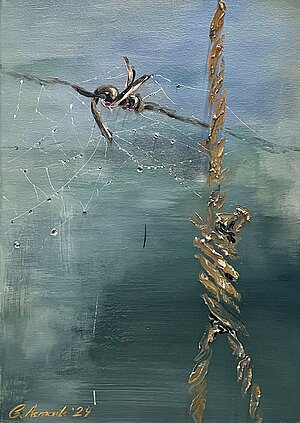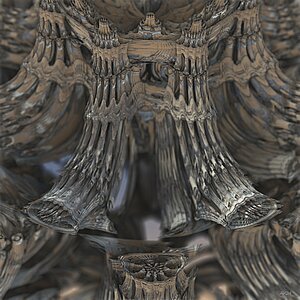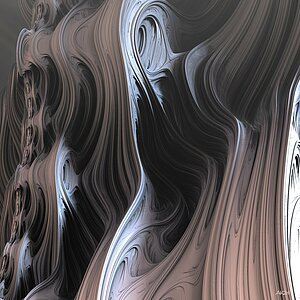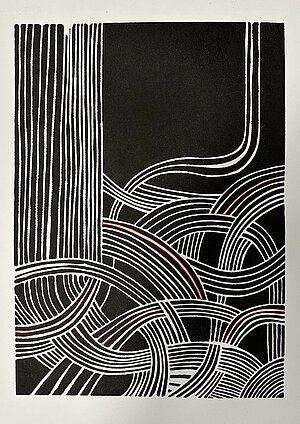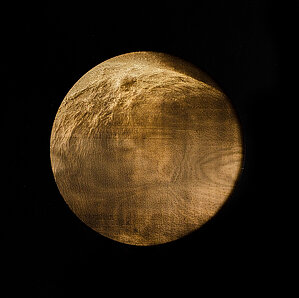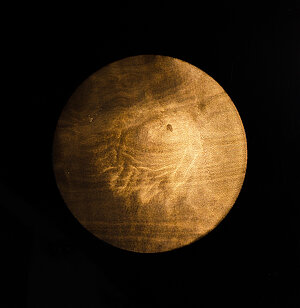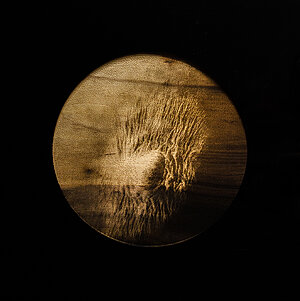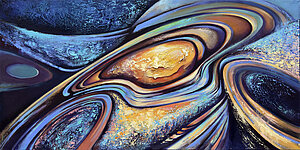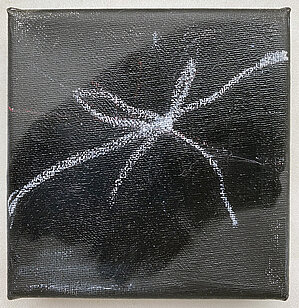Mezgli nav vienādi. Tie ir lieli un mazi, vienkārši un sarežģīti, cieši un vaļīgi, rūpīgi sieti, lai savienotu un saturētu kaut ko kopā, un nejauši vai pat negribēti sametušies, lai liktu mums apstāties līdz šim gludajā lietu plūdumā un pārdomāt iespējas. Nevēlamu mezglu var mēģināt lēni un pacietīgi atraisīt un atpiņķerēt, bet var pārcirst ar vienu cirtienu kā Maķedonijas Aleksandrs. Katrai izvēlei ir sekas.
Latvijas Universitātes (LU), Rēzeknes Tehnoloģiju akadēmijas (RTA) un Daugavpils Universitātes (DU) docētāju darbos mezgli atklājas visdažādākajos mērogos – no smalka zirnekļa tīkla pavediena līdz kosmosa galaktikām. Tie ir reāli, abstrakti, simboliski – katra autora iecere ir kā dāvanu kastes lenta, kuru var, protams, pārgriezt, bet var arī rūpīgi atsiet mezglus.
Not all knots are the same. They are big and small, simple and complex, tight and loose, carefully knotted to connect and hold something together, and accidentally or even unintentionally tangled to make us stop in the hitherto smooth flow of things and consider the possibilities. An unwanted knot can be slowly and patiently untied and untangled, or it can be cut with a single stroke, as Alexander of Macedon did. Every choice has consequences.
In the work of lecturers at the University of Latvia (UL), Rezekne Academy of Technologies (RAT) and Daugavpils University (DU), knots are revealed on a wide range of scales – from a tiny spider’s web to cosmic galaxies. They are real, abstract and symbolic – each author’s idea is like the ribbon of a gift box, which can, of course, be cut, but its knots can also be carefully untied.
Rita Broka (LU). PILSĒTAS AINAVA / URBAN LANDSCAPE
Kompozīcijā “Pilsētas ainava” attēlota pilsētas vide, kāda tā atklājas ielu tīklojuma virsmās agros, drēgnos, dubļu pelēkos pavasaros. Starp atkusuša sniega lāmām un pērnā gada lapu virpuļiem, ko garām steidzīgiem ikdienas soļiem mētā iesilušais vējš. Samītas, tumšu, glumu rakstu kārtojumos sagulušās lapu kārtas kā nolietotas un jēgu zaudējušas izdzīvotu notikumu drumslas, mēmi sairstot atkāpjas nevajadzīgajā pagātnē. Zeme silst un kautrīgi atsedz sapņu dzeltenos ziedus.
The composition “Urban Landscape” represents the urban environment as it unfolds in the network of sidewalks in early, wet, muddy-grey springs. Among the slush of melted snow and the swirls of last year’s leaves, which the warmed wind throws past hurried daily steps. Layers of sombre dark foliage piled up in layers and glum patterns, like worn-out and meaningless fragments of lived events, disintegrate dumbly into the unnecessary past. The earth warms up and shyly reveals the yellow flowers of dreams.
Agris Dzilna (LU). PA VIDU. Diptihs / IN BETWEEN. Diptych
Kāpnes un kāpņu telpa pašas par sevi ir ļoti ietilpīgi simboli.
Ja gribas, šo telpu var saukt arī par mezglu, un atliek tikai saprast, kāda ir tava saistība ar to.
Stairs and staircases are very capacious symbols in themselves.
If you like, you can also call this space a node, and all you have to do is understand what your relationship to it is.
Ilze Unzule (RTA). VIEDOKĻA MĀSA / OPINION SISTER
Es ar viņu tiekos regulāri. Mēs esam es. Mēs esam viņa. Mēs varam būt mēs, jo mūsu viedokļi sakrīt. Aizdomājos par to, cik mūsdienās ir droši vai nedroši paust savu viedokli publiski. Vai mēs varam atļauties riskēt? Vai mani sapratīs pareizi? Vai es kādu neaizskaršu? Gleznā attēloti divi tēli, kuri savā starpā nebaidās paust savu viedokli, uzskatus un pārliecību.
I see her regularly. We are me. We are her. We can be us because our opinions align. I wonder how safe or unsafe it is to express your opinion in public these days. Can we afford to take risks? Will I be understood correctly? Am I not going to offend anyone? The painting depicts two characters who are not afraid to express their opinion, views and beliefs to each other.
Māra Urdziņa-Deruma (LU). BEZ NOSAUKUMA / UNTITLED
Mūsu dzīve plūst ierastajā ritmā, veidojot daudzveidīgu līniju plūdumu. Līnijas dažkārt ir paralēlas, dažķārt tuvojas vai attālinās. Tomēr dažkārt tās krustojas un veidojas mezgli.
Our lives flow in their usual rhythm, forming a multifaceted flow of lines. The lines are sometimes parallel, sometimes closing in or moving away. Sometimes, however, they cross and form knots.
Natālija Brokāne (RTA). FOTOMEZGLI. Darbu sērija / PHOTONODES. Series of works
FOTOMEZGLI I, fotogrāfija
FOTOMEZGLI II, AI + fotografika
FOTOMEZGLI III, fotogrāfija, AI, fotografika
Pēdējā laikā MI fotogrāfija, ko Boriss Eldgasens apzīmējis kā “promptogrāfiju”, ir sasniegusi vēsu reālisma līmeni. Cik daudz mēs spējam mūsu realitātē atšķirt mākslīgo intelektu no reāla darba? Mākslīgais intelekts ir pilnīgi “samezglojis” mūsu domāšanu, uztveri un fantāziju; vieniem tas palīdz un atvieglo ikdienu, citiem tas atņem darbu un eksistences jēgu. Vai mākslīgais intelekts uzlabo vai sabojā mūsu topošās paaudzes nākotni, to varēs spriest tikai pēc laika, bet šobrīd gribas, lai neviens neaizmirst gūt mirkļus un baudu no realitātes!
PHOTONODES I, photography
PHOTONODES II, AI + photo graphics
PHOTONODES III, photography, AI, photo graphics
Recently, AI photography, which Boris Eldgasen has labelled “promptography,” has reached a chilling level of realism. How much we can distinguish artificial intelligence from real work in our reality? Artificial intelligence has completely “entangled” our thinking, perception and fantasy. For some it helps and makes everyday life easier, for others it takes away work and the meaning of existence. Whether AI improves or spoils the perspective of our future generation will only be known in time, but for now, we want to make sure that no one forgets to enjoy the moments and the realities!
Austra Celmiņa-Ķeirāne (LU). VAINAGS AR DIVIEM PUTNIŅIEM / A WREATH WITH TWO BIRDS
Gadsimtu vecs galdauts (vai pat vecāks), kas savulaik pieredzējis daudzus svinīgus brīžus un ģimenes viesības, tagad atdzimis jaunā veidolā, apvienojot dažādu laiku stāstus. Un mezglu tajā ir simtiem – vairāku rokdarbnieču mesti –, tikai tos nevar un nevajag redzēt.
A century-old tablecloth (or even older), which once witnessed many festive moments and family parties, is now reborn in a new form, combining stories from different times. And there are hundreds of knots – made by several craftswomen – but they cannot and should not be seen.
Agata Muze (LU). SAULES NOGURDINĀTĀ / BURNT BY THE SUN
Kad pienāk vasara, tad vēlme mesties baudīt siltumu ir milzīga. Gribas, lai saule iespiežas katrā šūnā… un velti Google brīdina, ka “pārlieku ilga uzturēšanās saulē var ne tikai saasināt dažādas veselības problēmas, bet tā var iegūt arī saules vai karstuma dūrienu”. Stingri apsienu lakatiņu un nolemju, ka gan jau būs labi…
When summer comes, the desire to rush to enjoy the warmth is huge. You want the sun to hug your every crevice, and in vain, Google warns that “staying in the sun for too long can not only aggravate various health problems but can also lead to sunstroke or heat stroke”. I tightly tie my scarf and decide it will be alright.
Solvita Zariņa (LU). LINGUA FRANCA. PASLĒPES / LINGUA FRANCA. HIDE AND SEEK
Mākslas darbs vienlaikus slēpj un parāda trīs konceptuālus aspektus: standartus, informācijas piesātinājumu un mijiedarbību. Mēs pazīstam angļu valodu kā mūsdienu globālās saziņas standartu jeb lingua franca. Esam pieraduši pie konferenču programmu standarta, meklējot un atrodot tur autoru sarakstu un viņu prezentāciju nosaukumus. Prezentāciju informācijas piesātinājums mērāms pirms konferences ieguldītā izpētes darba laikā. Piezīmes konferences programmā papildina drukātās informācijas piesātinājumu. Drukātais teksts šeit mijiedarbojas ar puscaurspīdīgajām akvareļkrāsu un skenētajām grāmatu vāku faktūrām. “Lingua Franca. Paslēpes” ir vienlaikus gan veltījums, gan mijiedarbība ar Mladena Stilinoviča mākslas darbu “An Artist Who Cannot Speak English Is no Artist”.
The artwork hides and reveals three main protagonists: Standard, Compression and Interaction. We know English as the standard tool for today’s global communication, as a lingua franca. We are used to the standard practise of printed conference programmes with a list of authors and the titles of their presentations. As a rule, days of research are compressed into a short presentation. The notes in the conference programme complement the compressed information of the printed text. Half-hidden printed text interacts with watercolour surfaces and scanned textures of book covers. “Lingua Franca. Hide and Seek” is a tribute to and interaction with Mladen Stilinovic's artwork “An Artist Who Cannot Speak English Is no Artist.”
Inguna Karlsone (LU). BEZMIEGA DOMA / THE INSOMNIA THOUGHT
Un tad tā ir klāt – nesaukta un negaidīta, ielaužas prāta dzīlēs, samezglojas, atrisinās un labākajā gadījumā… aiztinās.
And then it arrives – unexpected and uncalled for; it permeates the depths of your mind, twisting, tangling, untangling, and on the best of days… disappearing.
Gaļina Asmaite (LU). MEZGLOŠANA / KNOTTING
Mezgls ir pretrunīgs. Tas simbolizē ģimenes saišu stiprību un strupceļu, brīvību un ieslodzījumu, ierobežojumus un izvēles iespējas, kā arī dzīvības sākumu un beigas.
Darbā tiek attēloti trīs mezglu veidi: bezcerības, izvēles un dzīvības. Kur dzīvības mezglu veidojums vienam ir mājvieta un iztikas avots, tur otram – lamatas.
The knot is controversial. It symbolises the strength and deadlock of family ties, freedom and imprisonment, restrictions and choices, and the beginning and end of life.
The work depicts three types of knots: hopelessness, choice and life. Where the knotwork of life is a home and livelihood for one, it is a trap for the other.
Aldis Kopštāls (LU). LAUZTIE MEZGLI / BROKEN NODES
Izjūtās balstīta vizualizācija. Kad process sabrūk, rodas asas šķembas.
Fraktālās vizualizācijas tehnikā var daudzdimensionālu laiktelpu pārvērst divās dimensijās.
Feeling-based visualisation. When the process breaks down, sharp splinters emerge.
Fractal visualisation techniques can transform a multidimensional space-time into two dimensions.
Ilze Bodža (RTA). PLŪSMAS / FLOWS
Visi esam vienotā enerģijas plūsmā, kas vijas visdažādākajos virzienos un ceļos, vedot tā krustojas, mezglojas un ļauj ieskrieties taisnē. Plūduma pavedieni katru no mums ved savās takās. Ļauj dzīvei plūst!
We are all part of a single flow of energy that goes in many different directions and paths. As it leads, it intersects, knots and allows us to run in a straight line. The threads of the flow lead each of us on our paths. Let life flow!
Diāna Apele (RTA). TRAUSLAIS VISUMS II, III, IV / THE FRAGILE UNIVERSE II, III, IV
Darbu sērijā “Trauslais visums” atklājas visuma sievišķā daļa. Tā ir tikpat ievainojama, cik stipra vērtībās, kas saista ģimenes sievietes. Dzimtas piena trauslā dzīsliņa pārtop par stipru saikni jeb sava veida mezglu, kas nosaka planētu kustību un piederību vienai galaktikai – dzimtai. Planētas kā Visuma ķermeņi veidojas un attīstās, tā arī sievietes ķermenis vienmēr ir kustībā, krāj un nes sevī laika nospiedumus. Šī dzimtas “planētu” parāde ir apliecinājums autores pārliecībai par to, ka skaistais ir tikpat trausla vērtība kā laiks, taču katram laika sprīdim pieder savs skaistums. Darbu sērija “Trauslais visums” ir autores dziļi personisku izjūtu atsegšana, ietērpjot tās mākslinieciskos tēlos, taču aizskartās tēmas nenoliedzami ir vispārcilvēcīgi nozīmīgas un atspoguļo nezūdošas globālas vērtības.
In the series of works “The Fragile Universe II, III, IV”, the feminine part of the universe is revealed. It is as vulnerable as it is strong in the values that bind the women of the family. The fragile strand of the family’s milk transforms into a strong bond, or a kind of knot, that determines the movement of the planets and belonging to one galaxy – the family. The bodies of the planet as the universe are formed and developing, so the female body is always in motion, accumulates and carries within itself the imprints of time. This parade of “planets” of the family is a testament to the author’s belief that the beautiful is as fragile a value as time, but each time span has its beauty. The “The Fragile Universe” series of works is an exposing of the author’s deeply personal feelings by dressing them in artistic images, but the offended themes are undeniably of universal human significance and reflect enduring global values.
Ingrīda Irbe (LU). DIEGA MEZGLS / THREAD KNOT
Pirmā saskare ar mezglu man notika bērnībā, kad četru gadu vecumā pieteicos palīdzēt vecmāmiņai sasiet diegā mezglu.
Tas nepavisam nebija viegli. Nekas man nesanāca.
Tad parādījās vēl dažādi mezgli, kas man bija jāapgūst, – mezglu siešana kurpju šņorēs un lakatiņos, pionieru kaklautā u. tml.
Skolas gados, kad mācījos šūt, bez diegu mezgliem nekādi nevarēja iztikt, un tie man ir palikuši spožā atmiņā, tāpēc to arī attēloju uz audekla.
Tas bija viegli. Man sanāca.
My first contact with a knot was as a child when I volunteered to help my grandmother tie a knot at the age of four.
It was not easy. I could not manage anything.
Then there were various other knots that I had to learn - knotting shoelaces and scarves, the pioneer scarf and so on.
When I was learning to sew at school, there was no way I could do without thread knots, and they have remained a vivid memory for me, which is why I depicted them on canvas.
It was easy. I got it.

 Akadēmiskais centrs
Akadēmiskais centrs